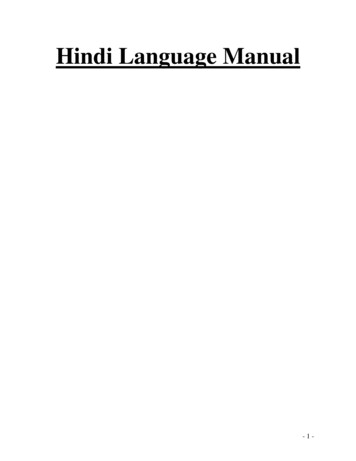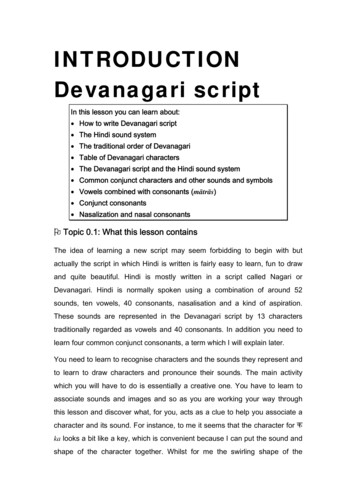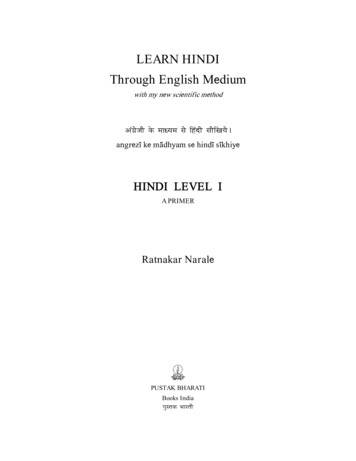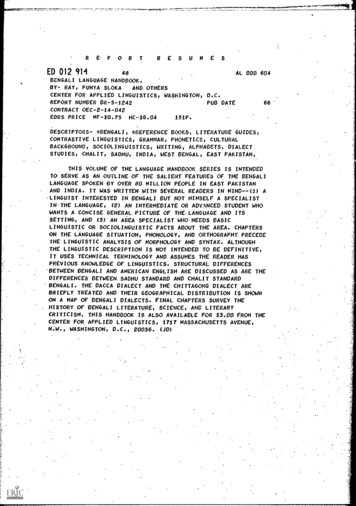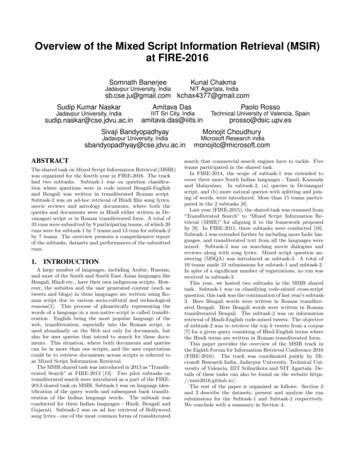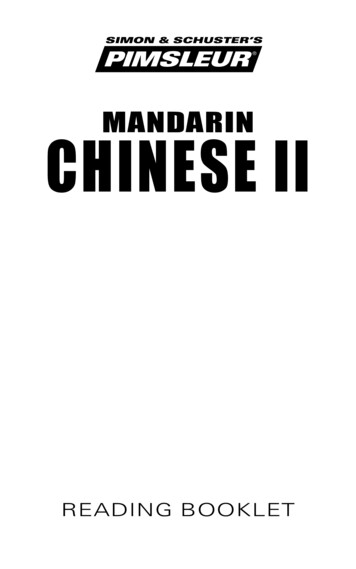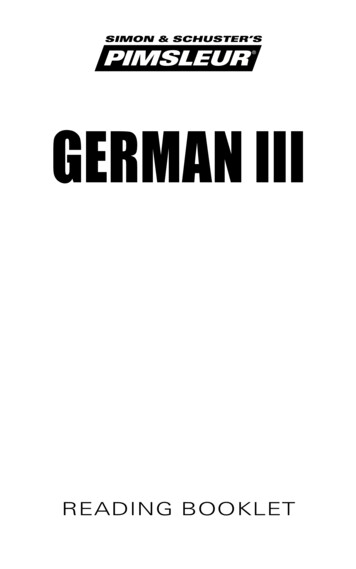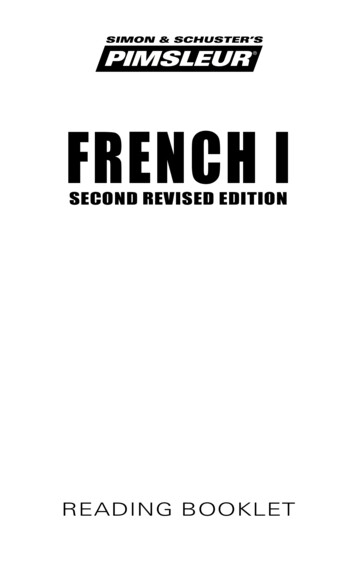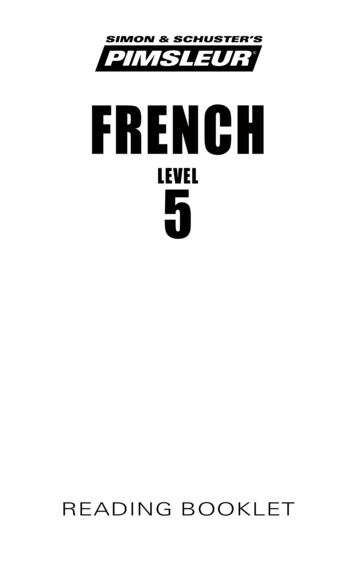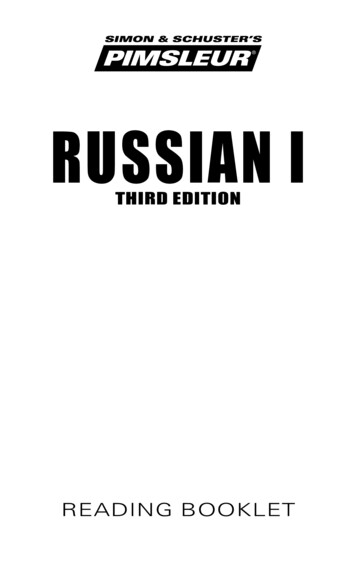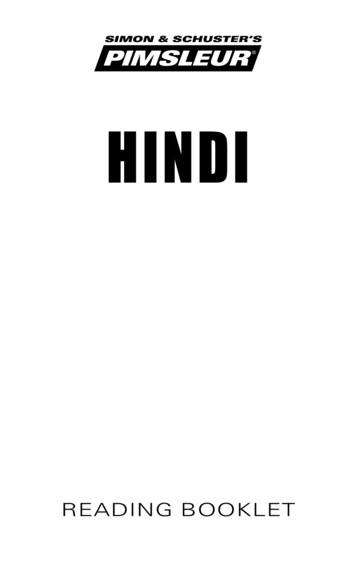
Transcription
SIMON & SCHUSTER’SPIMSLEUR Hindireading booklet
Travelers should always check with theirnation's State Department for currentadvisories on local conditions beforetraveling abroad.Graphic Design: Maia Kennedy and ‰ Recorded Program 2006 Simon & Schuster, Inc. Reading Booklet 2006 Simon & Schuster, Inc.Pimsleur is an imprint of Simon & Schuster Audio,a division of Simon & Schuster, Inc. Mfg. in USA.All rights reserved.ii
ACKNOWLEDGMENTSHINDIVoicesEnglish-Speaking Instructor. Ray BrownHindi-Speaking Instructor. Vivek MathurFemale Hindi Speaker. Dolly RajaMale Hindi Speaker.Bharat SinghCourse WritersDr. Jilani Warsi Christopher J. GaintyEditorsElizabeth Horber Beverly D. HeinleReviewersAnoop Bhargava Dilnavaz BamboatExecutive ProducerBeverly D. HeinleProducer & DirectorSarah H. McInnisRecording EngineersPeter S. Turpin Kelly SauxSimon & Schuster Studios, Concord, MAiii
Table of ContentsReading LessonsIntroduction . . 1Devanagari Alphabet . . 5Lesson One .Lesson Two .Lesson Three .Lesson Four . .Lesson Five .Lesson Six . .Lesson Seven .Lesson Eight .Lesson Nine .Lesson Ten .Lesson Eleven .Lesson Twelve . .Lesson Thirteen . .Lesson Fourteen .Lesson Fifteen . .Lesson Sixteen .Lesson Seventeen . .Lesson Eighteen .Lesson Nineteen . .Lesson Twenty .iv910111213141516171819202122232425262728
HINDIIntroductionHindi is one of 23 official languages of India, andis reported to be the second most commonly spokenlanguage in the world. (Only Mandarin Chinese hasa greater number of speakers.) Approximately 500million people around the world speak a dialect ofHindi, and an even greater number have at least somefamiliarity with it. India’s popular “Bollywood” filmshave served to expose viewers in many parts of theworld to the sounds of Hindi.However, included in those 500 million arespeakers of the many regional dialects of the language,which are often quite different. Hindustani is the termused to describe this closely related series of languagesor dialects, including Hindi and Urdu. In this course,we teach Standard Hindi as spoken in New Delhi.While elsewhere in India other dialects are moreprevalent, the New Delhi dialect will be understoodby most people you will meet. And while there are 23official languages, only Hindi and English are officialgovernment languages of communication.The Hindi language actually shares some rootswith English, as both are considered descendantsof the Indo-European parent language spoken inCentral Asia approximately seven thousand years
HINDIIntroduction (continued)ago. However, while English has its linguistic rootsin the West Germanic language family, Hindi is adescendant of the classical Sanskrit of Central Asiaand belongs to the Indo-Iranian family. Today, mostIndians are multi-lingual, speaking Hindi, English(one of the main dialects of English, called “IndianEnglish”), and one or more regional dialects.Hindi is a close relative of the Urdu languagespoken in Pakistan, and speakers of the two languagescan often understand one another, at least to someextent. Both languages are descendants of the colloquial Hindustani spoken in northern India in the ninthand tenth centuries. (The name “Hindi” is of Persianorigin, and was first used by Persian-speaking Turkswho established the “Delhi Sultanate” in the eleventhcentury A.D.) That said, the marked cultural differences between India and Pakistan have caused theHindi and Urdu languages to develop along somewhatdifferent lines, so that they are no longer entirelymutually comprehensible. Though extremely similar,the two are now considered separate languages. Urduis written in a Persian-Arabic script, while Hindi iswritten in the Devanagari script.2
HINDIIntroduction (continued)The written system of Hindi, known asDevanagari, dates back to approximately the 11thcentury A.D. There are also other languages,such as Sanskrit, Marathi, and Nepali, which usethe Devanagari script. A noticeable feature ofDevanagari is the top horizontal line which is formedwhen letters are combined. Hindi is read from leftto right and written with spaces between words.However, the letters which make up a word oftencombine and when the letters join together theysometimes change form. In Hindi there is a definitecorrespondence between spelling and pronunciation. There are a total of 11-14 vowels and33 - 36 consonants, depending on the chart used.There are no capital letters, but Hindi vowelshave a different appearance when they appearindependently or following another vowel thanthey do when they appear in a word following aconsonant. In a word following a consonant, theychange to what is known as a maatraa form. As amaatraa, a vowel can be placed before, after, above, orbelow a consonant. Devanagari also includes severaldiacritical marks, the chandrabindu and bindu, whichnasalize the vowels.3
HINDIIntroduction (continued)Since Hindi is written using the Devanagarialphabet, you will need to learn to associate thesounds with what is probably a new system ofsymbols. A listing of the Devanagari alphabet can befound beginning on page 5. This is for your referenceonly; you will not need the list to learn to read Hindi,since all of the instruction is on the audio.For more information, call1-800-831-5497 or visit usat www.Pimsleur.com4
HINDIDevanagari Alphabet — und*Maatraa Lettera as in aboutaa as in fatheraaii as in sitee as in seemeeu as in putuoo as in poolooa as in lateeia as in gladaeo as in goouaw as in sawauri as in gripThis vowel occurs only inwords that are borrowedfrom Sanskrit and is rarely.used in HindiriDiacritical Markschandrabindu – nasalizes vowelsbindu – nasalizes vowels––* The circle represents a consonant and shows therelative position of the maatraa to the consonant.5oँoं
HINDIDevanagari Alphabet — ConsonantsTransliterationSoundwithin a word or at the end of aword like the k in skit; sometimesक in the beginning of words the g asin goldख breathy-k as in tterkkhg as in gategbreathy-g as in dog-houseghng as in swingnch as in checkchbreathy-ch as in catch-him.Chchj as in Junejbreathy-j as in dodge-himjhThis sound does not exist inEnglish; most like the n in unjustcombination of t and d as in train /drainñTbreathy-t as in ant-hillThd as in dateDThis sound does not exist inEnglish; most like an r followed bya quick dbreathy-d with a very noticablebreath at the end6RaDh
HINDIDevanagari Alphabet — Consonants y-RaThis sound does not exist inEnglish; most like the n in endN.soft t as in at, or at-thetabreathy-tathad as in breadthdabreathy-dadhan as in name or anthemnap as in punpabreathy-p as in top-hatphab as in bunbabreathy-b as in clubhousebham as in mugmay as in youngyar as in sereneral as in lunchlabetween an English v and wvash as in shellshsh as in German SchneiderSh7
HINDIDevanagari Alphabet — Consonants (continued)Transliterationस s as in sunहSoundLetterSaHah as in headBorrowed Sounds — ConsonantsTransliteration क.ख.ग.ज़फ.SoundLetter)ct as in section (Sanskritksha)tr as in trishna (Sanskrittra)g-y combination (Sanskritgy)k (Arabicqa)ch as in loch (Persiankhha.)g (Persianghha.)z as in zone (Englishz)f as in fin (Englishf8
.17.17.18.18.19.19.20.20. 9
HINDILessonLessonTwo .12.12.13.13.14.14.15.15.16.16.17.17.18.18.19.19. / 10
6.16.17.17.18.18.19.19.20.20. 11
HINDILesson FourLesson Four1.1.2.2.3.3. 4.4. 5.5. 6.6. 7.7. 8.8. 9.9. 10.10. 11. 11.12. 12.13. 13.14. 14.15.15. 16. 16.17. 17.18. 18.12
HINDILessonLessonFive 1.12.12.13.13.14.14.15.15.16.16.17.17.18.18. 13
HINDILessonLessonSix Six1. 1.2. 2.3. 3.4. 4.5. 5.6. 6.7. 7.8. 8.9. 18.18. 14
6.16.17.17.18.18. 15
6.16.17.17.18.18. 16
16.17.17.18.18. / 17
HINDILessonLessonTen .12.12.13.13.14.14.15.15.16.16.17.17.18.18.19.19. 18
.16.16.17.17.18.18.19.19.20.20. 19
HINDILesson TwelveLesson Twelve1.1.2.2. 3.3. 4.4. 5.5. 6.6. 7.7. 8.8. 9.9. 10.10.11.11. 12.12. 13.13. 14.14. 15.15. 16.16. 17.17. 18.18. 20
HINDILesson ThirteenLesson Thirteen1.1.2.2. 3.3. 4.4. 5.5. 6.6. 7.7. 8.8. 9.9. 10.10.11.11. 12. 12.13.13. 14.14. 15. 15.16.16. 17.17. 18.18. 19.19. 21
HINDILesson FourteenLesson Fourteen1.1. 2.2. 3.3. 4.4. 5.5. 6.6. 7.7. 8.8. 9.9. 10. 10.11. 11.12.12. 13. 13.14.14. 15. 15.16. 16.17. 17.18. 18.19. 19.20. 20.22
HINDILesson FifteenLesson Fifteen1.1. 2.2. 3.3. 4.4. 5.5. 6.6. 7.7. 8.8. 9.9. 10. 10.11. 11.12. 12.13. 13.14. 14.15.15.16. 16.17.17. 18. 18.19. 19.23
HINDILesson SixteenLesson Sixteen1.1. 2.2. 3.3. 4.4.! 5.5.6.6. 7.7. 8.8. 9.9. 10. 10.11. 11.12. 12.13. 13.14. 14.15. 15.16.16. 17.17. 18. 18.19. 19.20. 20.24
HINDILesson SeventeenLesson Seventeen1.1. 2.2. 3.3.4.4.5.5. 6.6. 7.7. 8.8. 9.9. 10. 10.11. .11.12. .12.13. .13.14. 14.15. .15.16. 16.17. " 17.18. " .18.19. " .19.20. .20.25
HINDILesson EighteenLesson Eighteen1.1. 2.2. 3.3. !4.4. 5.5. 6.6. 7.7.# 8.8. 9.9.# .10. .10.11. 11.12. # 12.13. 13.14. 14.15. 15.16. 16.17.17. 18. ! 18.19. ! 19.20. ! .20.26
HINDILesson NineteenLesson Nineteen1.1. 2.2. 3.3. 4.4. 1 5.5. 1 * 6.6. 1& 7.7. (28.8. (2 9.9. %/10. 10.11. # 11.12. 12.13. ' 13.14. ' ! .14.15. 1 %15.16. 16.17. 1 % %.17.18. 118.19. 3) " ,?19.20. ) - 1 * .20.27
.16.16.17.17. & & & % % % % # " ! . .28
Indians are multi-lingual, speaking Hindi, English (one of the main dialects of English, called “Indian English”), and one or more regional dialects. Hindi is a close relative of the Urdu language spoken in Pakistan, and speakers of the two languages c

